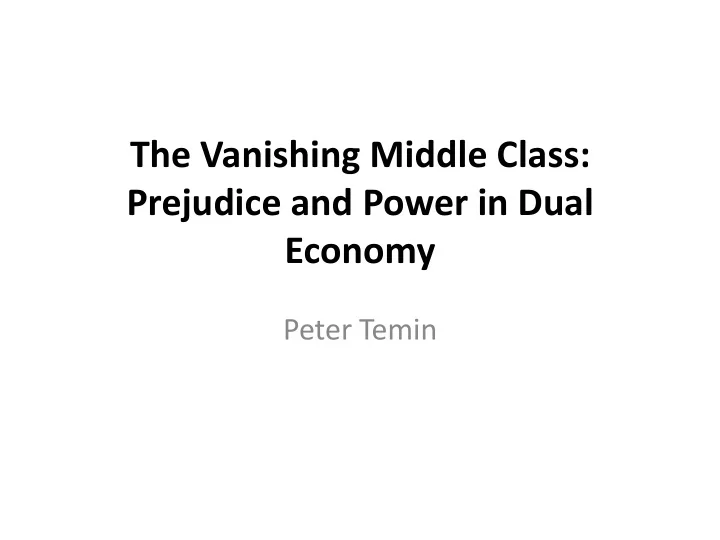

The Vanishing Middle Class: Prejudice and Power in Dual Economy Peter Temin
Figure 1 Percent of Aggregate US Income
A Dual Economy • W. Arthur Lewis, Manchester School , 1954 • Developing economies often had two sectors – “Capitalist” and “Subsistence” – Modern production and subsistence farming • Transition was by going to the city – For a higher expected wage – Higher wage X the probability of getting a good job
Lewis for the US Today • FTE sector: Finance, Technology, Electronics – 20% of the US labor force (from Fig. 1) – Earnings in this sector took off in the 1980s • Low-wage sector: most workers – 80% of the US labor force • Transition by education – College education needed to join the FTE sector – Necessary but not sufficient
The Top of the FTE Sector Top 1% Income Share in the United States 20% 19% 18% 17% 16% 15% 14% 13% 12% 11% 10% 9% 8% 7% 6% 5% 4% 3% 2% 1% 0% 1950 1952 1954 1956 1958 1960 1962 1964 1966 1968 1970 1972 1974 1976 1978 1980 1982 1984 1986 1988 1990 1992 1994 1996 1998 2000 2002 2004 2006 2008 2010 2012 2014 Year
Politics • FTE sector makes policy for itself – Ignores needs of the Low-wage sector • Top 1% (“Plutocrats”) dominates politics – They want low taxes, limited government • Top 1% of the top 1% supports individuals – Republican candidates for President – Conservative state governors • The very rich have no contact with the Low-wage sector
Investment Theory of Politics • Political scientists are surprised median voters don’t count – Policy decisions favor the rich • Median Voter Theorem is not helpful – It ignores participation and information • Investment Theory of Politics is very helpful – “Whoever has the gold rules.” – Shown in correlation (Ferguson, et al ., 2013)
Money and Votes in 2012 State Elections
The Low-wage Sector
Prejudice • Used to “sell” limited government services – Keeping blacks down • A long, long American practice – Nixon: the Southern Strategy – Reagan: announcing his candidacy in Philadelphia, MS – Trump: Making America “Great” Again • Hailed as the “New New Nixon”
The War on Drugs • War on Drugs started by Nixon – Expanded by Reagan and states in 1980s • Keeping us safe from crackheads – Three-strikes sentences spread in the 1990s • Blacks and whites both use drugs – But blacks are much more likely to go to jail – The war on drugs affects blacks more than whites
The New Jim Crow • One in three black males will go to prison during his lifetime (Bonczar, 2003) – Derived from life tables in 2001 – Still valid today; little has changed • This destroys black communities – Felons cannot vote in some states, access government programs, lack job training, etc. – Every family knows someone in jail
New Jim Crow Affects women and children • Black men in jail implies black women alone • Single-parent families are poor – They have to live in poor areas – With poor schools • Children are discouraged by bad schools – And also by the example of jailed fathers • Children drop out of school, go to jail, ...
Is the Low-wage sector black? • No; there are not enough blacks in the US – Blacks are about 15% of the total population – Low-wage sector is 80% of the total – Blacks are one-fifth of Low-wage workers • Latinos recently became as numerous as blacks – Another fifth of Low-wage workers • The majority of Low-wage workers are white – They were invisible and their needs are neglected
Why were low-wage whites invisible? • They did not vote – Data show that only half of voters voted – This is history; we cannot predict 2016 • More for President, less in other elections – Poll taxes, voter IDs, restricted and access affect whites and blacks • They get discouraged by loss of good jobs – They are dying younger – Why? drugs, suicide, etc.
Anger Politics • Coded words and deeds – Reagan: Welfare Queens – Trump: “We” and “Them” • Donald Trump has aroused poor whites’ anger – Poor whites oppose social welfare programs – Because they help “those people” • Poor whites get status by being above blacks – They become “great”
How to break this cycle • Reduce mass imprisonment – Which costs states around $50 billion a year • That money could be used to help education – States spend around $65 billion a year on state universities • Much better to educate than to jail people – Cooperation is better than conflict
Politics get in the way • The rich determine public policy – They want to lower their taxes – And to keep wages low • This fits the model of a Dual Economy – Policy is made by the higher (FTE) sector – Particularly by the “ Kochtopus ” (Jane Mayer) – Costs are borne by the low-wage sector • Flint, MI, water problems reveal this pattern
Global Income Growth
Coates, 2015 • “A society that protects some people through a safety net of schools, government-backed home loans, and ancestral wealth but can only protect you [my black son] with the club of criminal justice has either failed at enforcing its good intentions or has succeeded at something much darker.”
Recommend
More recommend